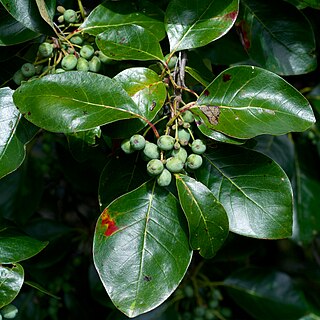
Eucalyptus sideroxylon, or mugga, red ironbark or mugga ironbark, is a small to medium-sized or occasionally tall tree that is found throughout eastern Australia.
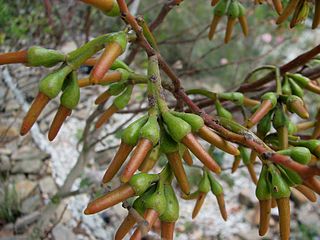
Eucalyptus eremophila is a eucalypt native to semi-arid regions of Western Australia. Common names include tall sand mallee, sand mallee, and Eastern Goldfields horned mallee.

Eucalyptus crebra, commonly known as the narrow-leaved ironbark or narrowleaf red ironbark, is a type of Ironbark tree native to eastern Australia. A member of the large genus Eucalyptus, this tree is in the Myrtaceae family and can grow to a large spreading tree up to 35 m (115 ft) high. It is an important source of nectar in the honey industry and its hard, strong timber is used in construction.

Eucalyptus obliqua, commonly known as the brown top, brown top stringbark, messmate, messmate stringybark, stringybark or Tasmanian oak, is a hardwood tree native to south-eastern Australia.

Eucalyptus grandis, commonly known as the flooded gum or rose gum, is a tall tree with smooth bark, rough at the base fibrous or flaky, grey to grey-brown. At maturity, it reaches 50 metres tall, though the largest specimens can exceed 80 metres tall.
It is found on coastal areas and sub-coastal ranges from Newcastle in New South Wales northwards to west of Daintree in Queensland, mainly on flat land and lower slopes, where it is the dominant tree of wet forests and on the margins of rain forests.

Eucalyptus leucoxylon, commonly known as yellow gum, blue gum or white ironbark, is a species of eucalypt that is endemic to Australia. It is widely distributed on plains and nearby mountain ranges or coastal South Australia, where it is known as the Blue Gum and extends into the western half of Victoria where it is known as the yellow gum.

Eucalyptus botryoides, commonly known as the Bangalay, bastard jarrah, woollybutt or Southern Mahogany, is a small to tall tree native to southeastern Australia. Reaching up to 40 metres high, it has rough bark on its trunk and branches. It is found on sandstone- or shale-based soils in open woodland, or on more sandy soils behind sand dunes. The white flowers appear in summer and autumn. It reproduces by resprouting from its woody lignotuber or epicormic buds after bushfire. E. botryoides hybridises with the Sydney blue gum in the Sydney region. The hard, durable wood has been used for panelling and flooring.

Eucalyptus robusta, commonly known as swamp mahogany or swamp messmate, is a tree native to eastern Australia. Growing in swampy or waterlogged soils, it is up to 30 m (98 ft) high with thick spongy reddish brown bark and dark green broad leaves, which help form a dense canopy. The white to cream flowers appear in autumn and winter. The leaves are commonly eaten by insects, and are a food item for the koala. It is an important winter-flowering species in eastern Australia, and has been planted extensively in many countries around the world. Its timber is used for firewood and in general construction.
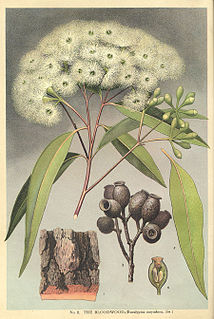
Corymbia gummifera, commonly known as red bloodwood, is a hardwood tree native to eastern Australia.

Eucalyptus oleosa, commonly known as the red mallee, glossy-leaved red mallee, acorn mallee, oil mallee or giant mallee. is a native tree of Australia The leaves were once harvested for the production of cineole based eucalyptus oil. Eucalyptus cneorifolia is now the predominant strain used in production due to a higher oil content in new growth.

Eucalyptus salmonophloia, known as wurak or Salmon Gum is an evergreen tree native to arid regions of Western Australia.
Eucalyptus cephalocarpa is a small to medium-sized tree,
native to and Victoria and New South Wales in Australia.

Eucalyptus fastigata, commonly known as brown barrel or cut-tail, is a common eucalyptus tree of south eastern Australia.

Eucalyptus sieberi, the silvertop ash or black ash, is a common eucalyptus tree of south eastern Australia. The range of distribution is in the higher rainfall areas, from near sea level to high altitude. Growing on shallow soils of medium to low fertility, south from Morisset, New South Wales to Victoria and Tasmania.
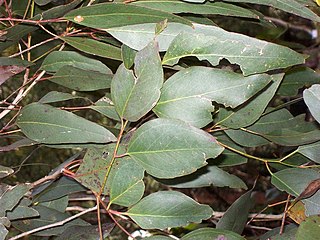
Eucalyptus bosistoana, the Coast Grey Box is a eucalyptus of south eastern Australia. It is the largest of the box group of eucalyptus trees, growing up to 60 metres tall, and a stem diameter of at least 1.5 metres. Though it is mostly seen from 25 to 40 metres tall. The specific epithet honours Joseph Bosisto, a manufacturer of essential oils.
Eucalyptus porosa is a species of eucalypt or gum tree, native to southern Australia. Common names include Water Mallee, Black Mallee, Black Mallee-box, Quorn Mallee, Peppermint Box, Whipstick Peppermint and South Australian Mallee Box.
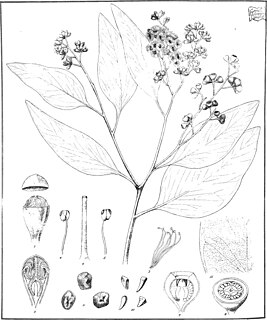
Eucalyptus behriana, commonly known as bull mallee and broad-leaved box, is a species of Eucalyptus that is endemic to south-eastern Australia. The species was formally described by Victorian Government Botanist Ferdinand von Mueller in 1855.
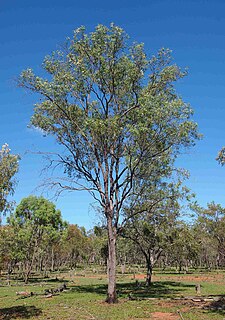
Eucalyptus exserta, commonly known as Queensland peppermint, peppermint, bendo, yellow messmate or messmate, is a tree native to New South Wales and Queensland in eastern Australia.
Eucalyptus melanoxylon or black morrell is a tree that is native to Western Australia.
